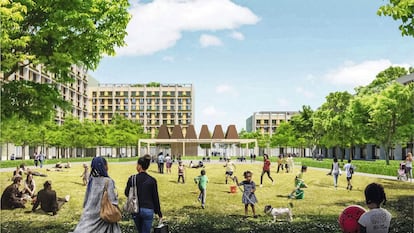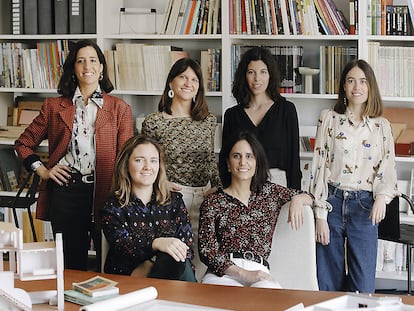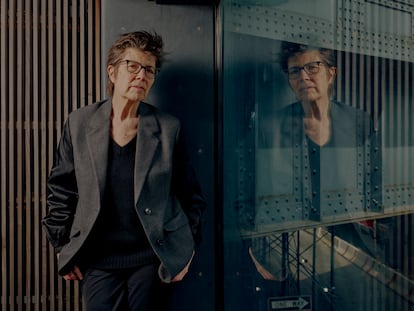Urban renewal in New York designed for longer life
A Brooklyn housing project aims to enhance the well-being of its residents by incorporating characteristics of Blue Zones — regions with the world’s highest life expectancy

The word alafia, in the language of the Yoruba (a West African ethnic group in parts of Nigeria, Benin and Togo), is associated with peace, well-being and good health. These are the goals of the Alafia housing project in one of the most marginalized parts of Brooklyn. In that area, around 30% of the population, mostly Black and Hispanic, live below the poverty line. The life expectancy of the people who live there is 78, three years lower than the average. These numbers are why the area was chosen for an experiment that hopes to improve the life expectancy of underserved citizens through a $1.2 billion state-funded urban renewal project. “Alafia is part of the Vital Brooklyn Initiative, which aims to connect housing with personal balance, well-being, employment, physical and social health support, and cultural and community spaces,” said Daniel Heuberger, a principal at Dattner Architects. The architecture firm is in charge of designing the 2,400-home complex on a 57-acre site, in collaboration with SCAPE, a landscape design company.
Spencer Orkus, from L+M Development Partners, one of the firms that developed the original proposal for Alafia, said that a New York Times article about Blue Zones was one of the inspirations for the project. Blue Zones, a concept popularized by Dan Buettner, a writer and explorer from Minnesota, are places around the world with a high incidence of people over 100 years old. Buettner identified five: Okinawa (Japan); Ikaria (Greece); Sardinia (Italy); Nicoya (Costa Rica); and Loma Linda (California). These environments share distinct characteristics — coastal proximity, minimal pollution, a cultural emphasis on friendship, and vegetable-based food traditions. An interesting characteristic of Loma Linda is the impact of the Seventh-day Adventist Church, whose members consume very little meat. Alcohol and tobacco consumption is also very low in this city 60 miles east of Los Angeles. According to Buettner, actively engaging in a religious community leads to longer life spans because it fosters communal living.
Can such a specific set of circumstances be transferred and implemented in a Brooklyn neighborhood? No, say the project developers, but it’s still an aspirational goal. Heuberger champions the “15-minute city” urban planning model, which advocates for easy access, within a quarter of an hour on foot or by bike, to basic needs and services near the residents’ homes. The Vital Brooklyn Initiative, launched in 2017, cites limited access to healthcare, fresh food and recreational spaces as factors contributing to the low quality of life in the area. “It all about creating a sense of community, that feeling of being part of a neighborhood, a place where you truly belong. That’s what really defines the Blue Zones,” explained Heuberger. “The project will generate jobs in the urban farm, which will be managed by residents, as well as in new local businesses.” Heuberger plans to complete the project by 2030. It will feature a supermarket, outpatient clinic, mental health center, recreational areas, a cultural center, as well as nutrition education and home food distribution for seniors. The buildings will utilize geothermal heating and cooling, and solar panels.
The project has skeptics, particularly because of the city-wide rezoning carried out by former Mayor Bill de Blasio. These changes have already led to a rise in rental prices, with housing on New York’s East Side now costing nearly double compared to 2015. The Alafia project aims to curb gentrification by offering affordable rentals. “We’ll use a lottery system to offer the homes, and some will be specifically set aside for folks who live nearby and have limited incomes,” said Heuberger. Living to 100 starts with being able to afford a home.
Sign up for our weekly newsletter to get more English-language news coverage from EL PAÍS USA Edition
Tu suscripción se está usando en otro dispositivo
¿Quieres añadir otro usuario a tu suscripción?
Si continúas leyendo en este dispositivo, no se podrá leer en el otro.
FlechaTu suscripción se está usando en otro dispositivo y solo puedes acceder a EL PAÍS desde un dispositivo a la vez.
Si quieres compartir tu cuenta, cambia tu suscripción a la modalidad Premium, así podrás añadir otro usuario. Cada uno accederá con su propia cuenta de email, lo que os permitirá personalizar vuestra experiencia en EL PAÍS.
¿Tienes una suscripción de empresa? Accede aquí para contratar más cuentas.
En el caso de no saber quién está usando tu cuenta, te recomendamos cambiar tu contraseña aquí.
Si decides continuar compartiendo tu cuenta, este mensaje se mostrará en tu dispositivo y en el de la otra persona que está usando tu cuenta de forma indefinida, afectando a tu experiencia de lectura. Puedes consultar aquí los términos y condiciones de la suscripción digital.
More information
Archived In
Últimas noticias
Most viewed
- Reinhard Genzel, Nobel laureate in physics: ‘One-minute videos will never give you the truth’
- Oona Chaplin: ‘I told James Cameron that I was living in a treehouse and starting a permaculture project with a friend’
- Pablo Escobar’s hippos: A serious environmental problem, 40 years on
- Why we lost the habit of sleeping in two segments and how that changed our sense of time
- Chevy Chase, the beloved comedian who was a monster off camera: ‘Not everyone hated him, just the people who’ve worked with him’











































